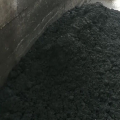|
|

樓主 |
發表於 2014-2-13 11:17:07
|
顯示全部樓層
本帖最後由 蘇少儀 於 2014-2-12 21:20 編輯
CME: Letters to Tyson's Hog Suppliers Request Changes in Pig Raising
13 January 2014
US - The rumored announcement by Tyson Foods regarding sow housing proved to be much, much more than that! Letters were sent to Tyson’s hog suppliers on Thursday (9 January) requesting a number of changes in the way they raise pigs, according to Steve Meyer and Len Steiner.
Recall from last week's discussion of Smithfield Foods' that contract farms are ones owned by individual operators (usually called growers) who take care of hogs owned by the contractor (often referred to, especially in the east, as the "integrator"). Tyson’s letter covered the following issues:
•An expansion of the number of third-party audits that will be done of sow farms in 2014 under Tyson’s Farm CheckTM animal well-being programme. The letter did not say how many audits will be required of suppliers, only that the number would increase.
•Use of video monitoring in sow farms to increase oversight and decrease biosecurity risks. Tyson pointed out its own experience in using video monitoring to improve human behavior and animal handling in its packing places. They will require contract farmers who care for Tyson’s sows to install video monitoring systems by the end of 2014. There is some concern among producers as to whether systems are available — at reasonable cost — that will withstand the rigors of hog barns.
•Ending the use of blunt force trauma as a primary method of euthanizing sick and injured piglets. Tyson recognized the long -standing use of the practice but stated that it "may not match the expectations of today’s customers or consumers." The company will require its contract producers to cease using blunt force euthanasia and adopt an alternative method consistent with the recommendations of the American Veterinary Medical Association (AVMA). Killing sick or injured pigs is simply an ugly thing that has to be done from time to time. Humane treatment requires it. Alternative systems are available. They do cost more but are already used by a significant number of producers.
•Support the development and use of pain mitigation for tail docking and castration. This is a new one among "welfare announcements" in the pork industry. The EU already requires some sort of pain mitigation for castration and prohibits tail docking (done to prevent tail biting among pigs later in the growing period). The company pledged to fund research on this topic and did not set a deadline for its contract growers.
•Improving sow housing systems by focusing on both quality and quantity of space provided. Tyson did not prohibit the use of gestation stalls per se but pretty effectively did so by stating that "future housing should allow sows of all sizes to stand, turn around, lie down and stretch their legs." The key one there is "turn around". To our knowledge, only one type of gestation stall (ie. one with swinging sides once sold by Moorman’s Manufacturing of Quincy, IL) will allow such movement. Beyond that, this aspect appears to require group housing systems. Tyson is requiring all contract grower to implement "quality and quantity" standards in any new or refurbished gestation barns beginning this year.
So why is this important? First, there is the issue of who is making the announcement. Tyson is the second largest pork packer with capacity of roughly 77,000 head per day. That compares to #1 Smithfield’s 117,000 head per day and an industry-wide total of 444,320. In addition, Tyson was ranked as the twelfth larges sow owner with 52,000 sows in last year’s Pork Powerhouses report from Successful Farming magazine. We could find no information on how many of those sows are in company-owned farms as opposed to contractor-owned facilities. So, the announcement comes from a major, major player.
Second, Tyson — or at least the "red meats" part of Tyson that was once IBP — is not known to give in to pressure. In fact, most observers probably remember when IBP never shied away from a fight if it believed principle was at stake. Further, it has been our impression that Tyson — or at least the pork portion of Tyson — has been a staunch supporter of producers who have fought pressure from the Humane Society of the United States and other animal rights activist groups. We point out that this "fight back" position is, for the most part, based on deeply held convictions that gestation stalls are the best system available for sow well-being. The producers might also be looking at costs and potential productivity changes, but their real driver is their belief that sows in group systems are, in fact, worse off than ones in stalls. The announcement did not mention that any particular group or customer had applied pressure but it does appear the company’s viewpoint has changed.
Finally, the breadth of the announcement is pretty shocking. Tyson did not stop at stalls and, as mentioned, addressed some topics that had not been cover by other companies’ announcements.
The National Pork Board issued a statement in which it quite understandably walked a fine line. The statement pointed out that there currently are no approved drugs for pain mitigation in pig farming. This is likely the reason for Tyson’s research pledge but it also suggests a very long timeline for this issue.
The Board reiterated its position which is supported by the AVMA and the American Association of Swine Veterinarians that there are numbers of ways to provide proper housing and care for sows. The statement pointed out that each system has advantages and disadvantages and that the key issue is that individual care must be given to each pig. That is a key tenant of the Board’s Pork Quality Assurance® Plus programme.
Finally the Board pointed out that video monitoring can be a useful tool for auditing animal welfare practices but that it is only one component of providing and ensuring good animal care. Further, the Board stated that video monitoring can add significant costs and should be balanced with a comprehensive approach to welfare that includes training.
==============================================================================
Smithfield Prods Its Pork Suppliers To Dump Pig Crates
by Eliza Barclay
January 07, 201411:57 AM
Smithfield, the world's largest hog and pork buyer, announced Tuesday that it's asking the independent farmers with whom it has contracts to get rid of stalls for pregnant sows to improve the animals' living conditions.
To nudge these farmers to make the changes to their facilities by 2022, Smithfield is offering to extend their contracts once they've converted their gestational stalls into group houses, which are generally considered more humane.
The move is significant because 40 percent of Smithfield sows are raised on farms owned by independent farmers. The company has contracts with 2,100 farms across 12 states.
Smithfield Foods, makers of ham products under a variety of brand names, is being purchased by Chinese food maker Shuanghui International, for $4.72 billion in cash.
The Two-Way
Smithfield Foods To Be Sold To Chinese Firm For $4.72 Billion
Smithfield, best known for its ham products, says it has already moved 54 percent of pregnant sows on its company-owned farms in the U.S. out of the the narrow stalls, known as gestation crates, and into group housing, per a commitment it made in 2007 to phase out the crates.
The hog industry's standard practice for years has been to confine pregnant sows in the 2-foot-wide steel crates for the length of their four-month pregnancies. The idea behind the crates is to keep the sows from squashing their babies, fighting and stealing each others' food.
But animal welfare groups have long called the crates cruel and unnecessary, and pressured big producers like Smithfield to end the practice. Advocates argue that the crates restrict the animals' movement too much — the sows can't turn around at all — and are simply devices to pack as many animals into a house as possible. (Smithfield alone used 15.8 million hogs in 2012.) Group houses, by contrast, are bigger, and allow pregnant sows to come and go from their stalls.
Smithfield's announcement comes as 60 of the world's largest food retailers – from McDonald's to Safeway, Costco and Oscar Mayer – have said they won't tolerate gestation crates in their supply chains anymore, either.
In a press release, Smithfield said that the change it is requesting is not required, but contract extensions "will be less likely" for farmers who keep gestation crates.
"We recognize that these projects require a significant investment on the part of our growers," C. Larry Pope, president and chief executive officer of Smithfield Foods, said in a statement. "But a well-planned renovation to a group housing system will help maintain the farms' value for years to come, while at the same time supporting our companywide commitment to animal care."
The Humane Society of the U.S. says that Smithfield's announcement spells the eventual end of the gestation crate.
"Smithfield's announcement means certain death for the gestation crate in pork production," Matthew Prescott, food policy director for HSUS, tells The Salt. "For the millions of pigs currently locked inside these cruel boxes, that demise will be most welcomed." |
|


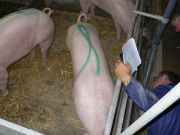
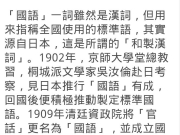
![越南非洲豬瘟疫苗蒙陰影 上百豬隻接種後死亡[轉貼]](data/attachment/block/3e/3e723490e252eebc3bc1a403febd226e.jpg)
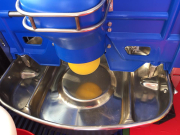
![[轉貼]從上市9頭到14頭 -- 我的養豬專業養成之路。](data/attachment/block/3c/3c17fd6b5c1b8cff34fdc7342238e082.jpg)
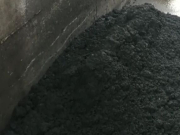

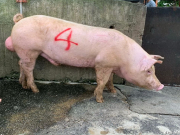
![[轉貼]這個倒霉王國,因為一隻老鼠慘遭滅國 .....](data/attachment/block/3f/3ffb7b6b8ec14613dc077bdd7603e3a5.jpg)
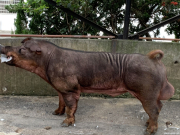
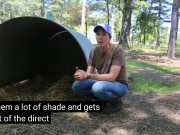


 IP卡
IP卡 狗仔卡
狗仔卡 發表於 2014-2-13 11:12:21
發表於 2014-2-13 11:12:21
 提升卡
提升卡 置頂卡
置頂卡 沉默卡
沉默卡 喧囂卡
喧囂卡 變色卡
變色卡 搶沙發
搶沙發 千斤頂
千斤頂 顯身卡
顯身卡 樓主
樓主
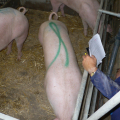

![越南非洲豬瘟疫苗蒙陰影 上百豬隻接種後死亡[轉貼]](data/attachment/block/d2/d2539d8909b33105a4f3e3b9b2e8a659.jpg)
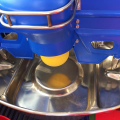
![[轉貼]從上市9頭到14頭 -- 我的養豬專業養成之路。](data/attachment/block/81/819f9b837f86a7e00498f8d95b8b9176.jpg)
